International Toy Fair Nuremberg 2010
Internationale Spielwarenmesse Nürnberg 2010
| x |
|
|
|
|
|
|
|
|
|
|
|
|
|
|
|
|
|
|
|
|
|
|
|
|
|
|
|
|
|
|
|
|
|
|
| Hans im Glück |
|
|
| x |
|
|
|
|
|
|
|
|
|
|
|
|
|
|
|
|
|
|
|
|
|
|
|
|
|
|
|
|
|
|
|
|
|
|
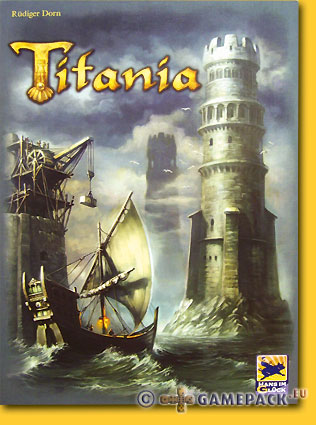 |
Never leave the author and the artist alone; they might come up with weird things like collecting shells and building towers with it! |
|
|
|
|
|
|
|
|
|
|
|
|
|
|
|
|
|
|
|
|
|
|
|
|
|
|
|
|
|
|
|
|
|
|
|
|
| In a turn, a player may play one to three cards and place the corresponding coloured ship (if there are more colours on the card, choose one) on a hex next to a ship of the same colour. A hex can only hold two ships of different colours. Note that the ships do not belong to a player. On the board various symbols are preprinted, but fog chits that are turned face up when a ship enters the hex also carry these symbols. Most of them earn shells in a particular colour, or sea stars. |
|
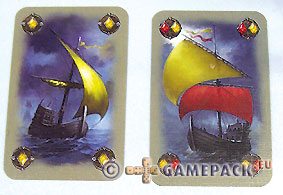 |
|
| x |
|
|
|
|
|
|
|
|
|
|
|
|
|
|
|
|
|
|
|
|
|
|
|
|
|
|
|
|
|
|
|
|
|
|
 |
|
| x |
|
|
|
|
|
|
|
|
|
|
|
|
|
|
|
|
|
|
|
|
|
|
|
|
|
|
|
|
|
|
|
|
|
|
| When a player has placed a ship on a hex with a construction crane, he is allowed to build on towers on all adjacent hexes but he must build at least one stock. To build, a player needs shells in the colour of the tower depicted; one for the first stock, two for the second, up to four for the fourth and highest stock. For each stock built, he gets three points; four if a sea star is in the hex. |
|
| x |
|
|
|
|
|
|
|
|
|
|
|
|
|
|
|
|
|
|
|
|
|
|
|
|
|
|
|
|
|
|
|
|
|
|
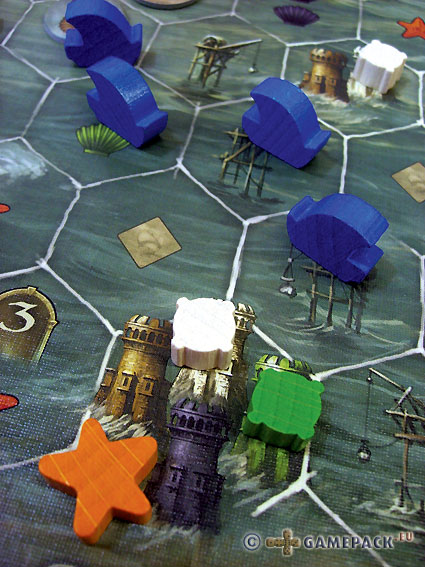 |
|
Each time a player gains a sea star he immediately may place it on any tower hex or save it for later use. To place a sea star, a player must pay as many sea stars as there are towers depicted in the hex, so in the illustration on the left a player would have paid four sea stars, one of which is placed in the hex. After this the player gains as many points as there are towers depicted.
When in a later turn any one player builds in the hex with a sea star, each built stock earns four points insc of three.
|
|
| x |
|
|
|
|
|
|
|
|
|
|
|
|
|
|
|
|
|
|
|
|
|
|
|
|
|
|
|
|
|
|
|
|
|
|
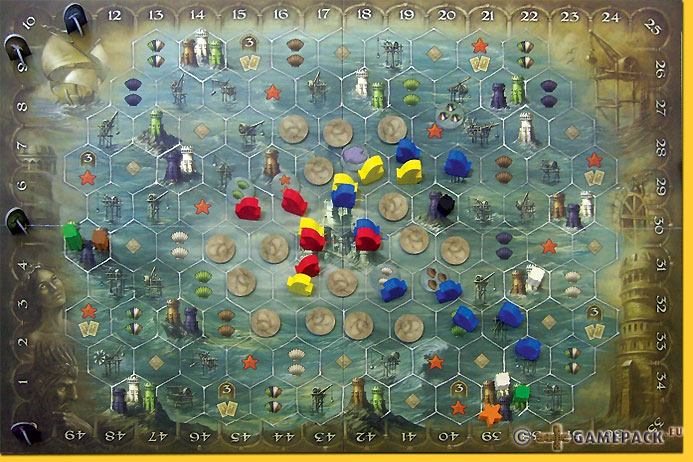 |
| x |
|
|
|
|
|
|
|
|
|
|
|
|
|
|
|
|
|
|
|
|
|
|
|
|
|
|
|
|
|
|
|
|
|
|
After his move, a player refills his hand: three cards if he has played no cards at all through no cards if he has played three cards, and everything in between.
When the last ship of a colour has been placed on the board, the first round ends: all ships except the six in the middle of the board are removed together with all sea stars, and the fog chits all are removed, mixed and placed blind on the board on the indicated hexes. A second and last round begins with already some stocks or towers on the board. |
|
| x |
|
|
|
|
|
|
|
|
|
|
|
|
|
|
|
|
|
|
|
|
|
|
|
|
|
|
|
|
|
|
|
|
|
|
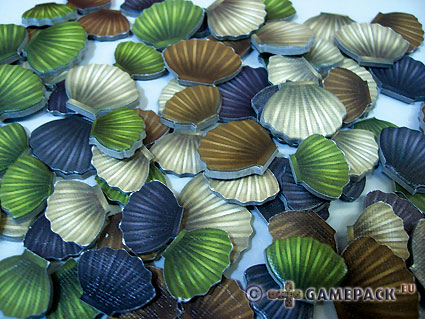 |
|
Be sure to play the game under excellent light conditions: the colour of the shells are a bit too subtle to distinguish when not illuminated by surgery lights... |
|
| x |
|
|
|
|
|
|
|
|
|
|
|
|
|
|
|
|
|
|
|
|
|
|
|
|
|
|
|
|
|
|
|
|
|
|
| Titania, Rüdiger Dorn, Hans im Glück, 2010 - 2 to 5 players, 10 years and up, 60 minutes |
|
| x |
|
|
|
|
|
|
|
|
|
|
|
|
|
|
|
|
|
|
|
|
|
|
|
|
|
|
|
|
|
|
|
|
|
|
| x |
|
|
|
|
|
|
|
|
|
|
|
|
|
|
|
|
|
|
|
|
|
|
|
|
|
|
|
|
|
|
|
|
|
|
| x |
|
|
|
|
|
|
|
|
|
|
|
|
|
|
|
|
|
|
|
|
|
|
|
|
|
|
|
|
|
|
|
|
|
|
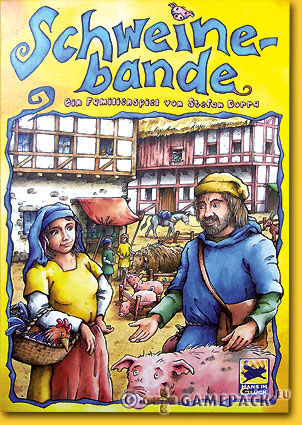 |
Players are peasants, yes they are! At least in this game, where they go to the market to acquire animals. They feed them too. They are good, simple peasants. They collect points and are happy. Ah, life was good! We could keep all the money for ourselves back then - nowadays we have to move our companies to China and negotiate (we have to tálk with them!) for the same conditions...
In four rounds, the animal chits are turned face up one by one. Players may place a farmer on a revealed animal marker, or pass. When a player has placed his last farmer on a chit, he takes the lowest player order marker. Other players continue until there is only one player left who continues until he has placed his last farmer. In the event not all animals were revealed, these now are turned face up too.
Starting with number 1, a player may collect animals. He chooses any one of his farmers and takes all animals in any one row starting from this farmer, only limited by the border or another farmer. |
|
| x |
|
|
|
|
|
|
|
|
|
|
|
|
|
|
|
|
|
|
|
|
|
|
|
|
|
|
|
|
|
|
|
|
|
|
 |
|
| x |
|
|
|
|
|
|
|
|
|
|
|
|
|
|
|
|
|
|
|
|
|
|
|
|
|
|
|
|
|
|
|
|
|
|
| Collected animals are placed in front of a player, with similar animals in a column. Players now may take animals to their farm if they have four similar of them, for instance four goats. He places one at the farm, the other three go out of the game. A group of six has to contain six different animals, so one of each. The player takes the ox and puts it on his farm, the other animal chits go out of the game. |
|
| x |
|
|
|
|
|
|
|
|
|
|
|
|
|
|
|
|
|
|
|
|
|
|
|
|
|
|
|
|
|
|
|
|
|
|
 |
|
In the fourth and last round there is an extra bonus for pigs: having four of them collected gives a player the privilege of placing two of them on the farm; did he collect eight, he may place four, etc.
All animals that are not on a farm must be fed; each animal needs one food. If a player does not have enough food, he must sell one or more animals. An animal earns as many food as its value. |
|
| x |
|
|
|
|
|
|
|
|
|
|
|
|
|
|
|
|
|
|
|
|
|
|
|
|
|
|
|
|
|
|
|
|
|
|
In the last round, after feeding, players may bring an extra animal to the farm if part of a four series. These can be any animals, but now the lowest value animal goes tot he farm. All animals on the farm are counted after this, with ties for a player with the most pigs on his farm.
Nice to see Doris Matthäus' drawings again.
|
|
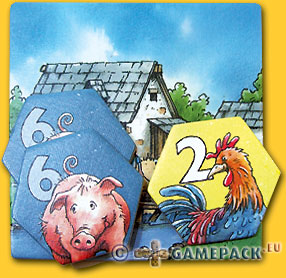 |
|
|
|
|
|
|
|
|
|
|
|
|
|
|
|
|
|
|
|
|
|
|
|
|
|
|
|
|
|
|
|
|
|
|
|
|
| Schweinebande, Stefan Dorra, Hans im Glück, 2010 - 2 to 5 players, 8 years and up, 30 minutes |
|
| x |
|
|
|
|
|
|
|
|
|
|
|
|
|
|
|
|
|
|
|
|
|
|
|
|
|
|
|
|
|
|
|
|
|
|
| x |
|
|
|
|
|
|
|
|
|
|
|
|
|
|
|
|
|
|
|
|
|
|
|
|
|
|
|
|
|
|
|
 |
|
|
|
|
|
|
|
|
|
|
|
|
|
|
|
|
|
|
|
|
|
|
|
|
|
|
|
|
|
|
|
|
|
 |
|
|
|
|
|
|
|
|
|
|
|
|
|
|
|
|
|
|
|
|
|
|
|
|
|
|
|
|
|
|
|
|
|
 |
|
|
|
|
|
|
|
|
|
|
|
|
|
|
|
|
|
|
|
|
|
|
|
|
|
|
|
|
|
|
|
|
|
 |
|
|
|
|
|
|
|
|
|
|
|
|
|
|
|
|
|
|
|
|
|
|
|
|
|
|
|
|
|
|
|
|
|
 |
|
|
|
|
|
|
|
|
|
|
|
|
|
|
|
|
|
|
|
|
|
|
|
|
|
|
|
|
|
|
|
| x |
|
|
|
|
|
|
|
|
|
|
|
|
|
|
|
|
|
|
|
|
|
|
|
|
|
|
|
|
|
|
|
|
|
|
 |
|
|
|
|
|
|
|
|
|
|
|
|
|
|
|
|
|
|
|
|
|
|
|
|
|
|
|
|
|
|
|
|
|
|
|
|
|
|
|
|
|
|
|
|
|
|
|
|
|
|
|
|
|